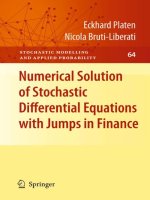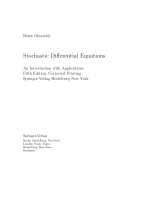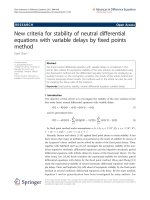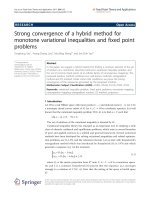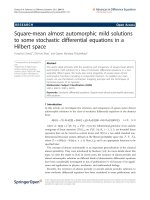Strong Rate of Tamed EulerMaruyama Approximation for Stochastic Differential Equations with H¨older Continuous Diffusion Coefficient
Bạn đang xem bản rút gọn của tài liệu. Xem và tải ngay bản đầy đủ của tài liệu tại đây (321.64 KB, 20 trang )
Strong Rate of Tamed Euler-Maruyama
Approximation for Stochastic Differential
Equations with H¨older Continuous Diffusion
Coefficient
Hoang-Long Ngo∗ and
Duc-Trong Luong†
Hanoi National Univesity of Education
Abstract
We study the strong rate of convergence of the tamed Euler-Maruyama
approximation for one-dimensional stochastic differential equations
with superlinearly growing drift and H¨older continuous diffusion coefficients.
1
Introduction
Let us consider a stochastic differential equation (SDE for short)
t
t
b(s, Xs )ds +
X t = x0 +
0
σ(s, Xs )dWs ,
x0 ∈ R, t ∈ [0, T ],
(1.1)
0
where (Wt )0≤t≤T is a standard Brownian motion defined on a filtered probability space (Ω, F, (Ft )t≥0 , P).
It is well-known that when b and σ are Lipschitz continuous, the standard
Euler-Maruyama approximation scheme for (Xt ) has a strong rate of convergence of order 1/2 (see Kloeden, P. and Platen, E. (1995)). Recently, there
∗
†
1
have been extensive studies on the strong approximations of SDE (1.1) with
non-Lipschitz coefficients. The rates of Euler-Maruyama scheme for SDEs
with H¨older continuous diffusion coefficients have been investigated by Yan,
B.L. ((2002)), Gy¨ongy, I. and R´asonyi, M. (2011), Ngo, H-L. and Taguchi,
D. (2013) (see also Alfonsi, A. (2005); Berkaoui, B., Bossy, M. and Diop, A.
(2008); Dereich, S., Neuenkirch, A. and Szpruch, L. (2012) for many strong
approximation schemes proposed for Cox-Ingersoll-Ross type model). Hairer,
M., Hutzenthaler, M. and Jentzen, A. (2012) have proposed an example of
SDE with globally bounded and smooth coefficients that although the standard Euler-Maruyama approximation converge to the exact solution of the
SDE in both strong and weak senses but there is no positive polynomial rate
of convergence. Moreover, Hutzenthaler, M., Jentzen, A. and Kloeden, P. E.
(2011) have showed that if b is superlinear growth then the absolute moments
of the standard Euler-Maruyama approximated solution may diverge to infinity while the ones of the true solution is finite. Therefore, the standard
Euler-Maruyama scheme may fail to convergence in Lp sense. There are two
methods to overcome this difficulty. The first method named implicit EulerMaruyama scheme was proposed by Higham, D. J., Mao, X. and Stuart, A.
M (2002), and Hu, Y. (1996). A drawback of the implicit scheme is that at
each simulation step, one needs to solve an algebraic equation which may not
have an explicit solution. Hutzenthaler, M., Jentzen, A. and Kloeden, P.E.
(2011)) and Sabanis, S. (2013) have recently introduced the second method
named tamed Euler scheme. It is an explicit scheme in which the drift coefficient is modified so that it is bounded. It has been shown that when the
diffusion σ is Lipschitz continuous and the drift b is superlinear growth and
one-sided Lipschitz, the tamed Euler scheme has a strong rate of order 1/2.
In this article we study the strong convergence rate of the tamed EulerMaruyama schemes applied to the SDE (1.1) where b is superlinear growth
and σ is H¨older continuous. This partly generalizes the results in Gy¨ongy,
I. and R´asonyi, M. (2011); Hutzenthaler, M., Jentzen, A. and Kloeden, P.E.
(2011)) in the one-dimensional framework. The main contributions of the
current paper are:
• Establishing a new sufficient condition for the existence and uniqueness
of strong solution for one-dimensional SDEs with locally H¨older continuous diffusion coefficient and superlinearly growing drift coefficient;
• Showing the strong convergence (in Lp sense) of the tamed EulerMaruyama approximation for these SDEs;
2
• Obtaining the order of these approximation errors.
The rest of the paper is organized as follows. The next section introduces
some notations and assumptions. All main results are presented in Section
3 while their proofs are given in Section 4.
2
Notations and Assumptions
For integers n ≥ 1, we define ηn (s) : [0; T ] → [0; T ] by ηn (t) =
kT
n
(n)
:= tk
; (k+1)T
. The tamed Euler-Maruyama approximation of equation
if t ∈ kT
n
n
(1.1) is defined as follows
(n)
Xt
t
= x0 +
0
t
(n)
bn (s, Xηn (s) )ds +
0
(n)
σ(s, Xηn (s) )dWs ,
t ∈ [0, T ]
(2.1)
1
with bn (t, x) = 1+nb(t,x)
−λ |b(t,x)| for some λ ∈ 0; 2 . Note that if bn is replaced by
b in (2.1) then X (n) is called the standard Euler-Maruyama approximation.
We will make the following assumptions:
A1. There exists a positive constant L such that
xb(t, x) ∨ |σ(t, x)|2 ≤ L(1 + |x|2 )
for any x ∈ R and t ∈ [0; T ].
A2. b is one-sided Lipschitz: there exists a positive constant L such that
(x − y)(b(t, x) − b(t, y)) ≤ L|x − y|2
for any x, y ∈ R and t ∈ [0; T ].
A3. There exist positive constants L and l such that
|b(t, x) − b(t, y)| ≤ L 1 + |x|l + |y|l |x − y|,
and
|b(t, x)| ≤ L(1 + |x|l+1 )
for any x, y ∈ R and t ∈ [0; T ].
3
A4. σ is (α + 21 )-H¨older continuous: there exist positive constants L and
α ∈ (0, 12 ] such that
|σ(t, x) − σ(t, y)| ≤ L|x − y|1/2+α
for any x, y ∈ R and t ∈ [0; T ].
A5. b is locally Lipschitz and locally bounded: for any R > 0, there exists
a positive constant LR > 0 such that
|b(t, x) − b(t, y)| ≤ LR |x − y|
and |b(t, x)| ≤ LR for all |x| ∨ |y| ≤ R and t ∈ [0, T ].
A6. σ is locally (α + 21 )-H¨older continuous: for any R > 0, there exist
positive constants LR and α ∈ (0, 21 ] such that
|σ(t, x) − σ(t, y)| ≤ LR |x − y|1/2+α
for all |x| ∨ |y| ≤ R and t ∈ [0, T ].
It is clear that the Assumptions A3 and A4 imply the Assumptions A5 and
A6, respectively.
3
Main Results
The existence and uniqueness of solution for SDEs with H¨older continuous
diffusion coefficient and bounded measurable drift has been established in
Veretennikov, A.Yu. (1981) (see also Gy¨ongy, I. and Krylov, N.V (1996); Yamada, T. and Watanabe, S. (1971)). In the following, we show the existence
and uniqueness of solution to equation (1.1) under Assumptions A1, A5 and
A6.
Theorem 3.1. (i) Suppose that A1, A5, A6 hold, and equation (1.1) has a
solution (Xt )t∈[0,T ] then it is the unique solution.
(ii) Suppose that A1, A5, A6 holds, and there exist positive constants C and
l such that
sup |b(t, x)| ≤ C 1 + |x|l ,
t∈[0,T ]
then equation (1.1) has a strong solution.
4
Example 3.1. For clarity of exposition we consider the following SDE
t
t
σ|Xs − K|1/2+α ,
(aXs − bXs3 )ds +
X t = x0 +
(3.1)
0
0
where b is a non-negative constant, α ∈ [0, 21 ] and x0 , a, σ, K ∈ R. It is
straightforward to verify that coefficients of this SDE satisfy Assumptions
A1–A4. Therefore equation (3.1) has a unique strong solution. If b > 0, it
follows from Theorem 2.1 in Hutzenthaler, M., Jentzen, A. and Kloeden, P.
E. (2011) that the standard Euler-Maruyama approximated solution of (3.1)
does not have a finite moment of any order p ≥ 1 while Xt ’s have finite moments of all order (Lemma 4.1). It means that the standard Euler-Maruyama
approximation for equation (3.1) does not converge in strong sense.
In the following we always assume that the equation (1.1) has a unique
strong solution. Moreover, we choose λ ∈ [α, 21 ] for the tamed Euler-Maruyama
approximation (2.1).
Theorem 3.2. Suppose that A1–A4 hold, then there is a constant C > 0
independent of n such that
C
nα
C
log n
sup E |Xτ − Xτ(n) | ≤
τ ∈T
if α ∈ 0, 12 ,
if α = 0,
where T is the set of all stopping times τ ≤ T .
Corollary 3.3. Suppose that A1–A4 hold, then there is a constant C > 0
independent of n such that
E
sup |Xt −
0≤t≤T
(n)
Xt |
≤
C
n2α2
√C
log n
if α ∈ 0, 21 ,
if α = 0.
The following estimates for the moments of strong approximation errors
play an important role in designing a Multilevel Monte Carlo scheme to estimate E[F (X)] for some function F defined on C[0, T ] (see Giles, M. (2008)).
Theorem 3.4. Suppose that A1-A4 hold, then for all p > 0, there is a
constant Cp > 0 depend on p and independent of n such that
C
p
if α = 12 ,
np/2
p
(n)
E sup Xt − Xt
≤ nCαp
if α ∈ 0; 21 and p ≥ 2,
0≤t≤T
Cp
if α = 0 and p ≥ 2.
log n
5
We note here that that the strong rates of the tamed Euler-Maruyama
approximation obtained in Theorems 3.2, 3.4 and Corollary 3.3 are the
same as the ones of the standard Euler-Maruyama approximation applied
to SDEs with H¨older continuous diffusion coefficient and linear growth drift
(see Gy¨ongy, I. and R´asonyi, M. (2011)).
Finally we show the convergence of tamed Euler-Maruyama scheme under
the local Lipschitz condition on b and local H¨older continuous condition on
σ.
Theorem 3.5. Suppose that A1, A5 and A6 hold. Then for any p > 0,
lim E
n→∞
4
(n)
sup Xt − Xt
p
= 0.
0≤t≤T
Proofs
In the following we will first prove Theorems 3.2–3.5. The proof of Theorem
3.1 will be given at Sections 4.6 and 4.7.
Throughout this section C denotes some positive constants which may
depend on L, l, T, α and x0 but independent of n and t. When C depend on
p or R we denote C by Cp or CR , respectively.
4.1
Some auxiliary estimates
(n)
(n)
(n)
(n)
(n)
Denote Ut = Xt − Xηn (t) and Yt = Xt − Xt . We need the following
bounds on moments of X and X (n) which are direct consequences of Lemmas
3.1–3.3 in Sabanis, S. (2013).
Lemma 4.1. Suppose that A1 holds, then for any p > 0, there exists a
constant Cp > 0 such that
E
sup |Xt |p ∨ sup E
n≥1
0≤t≤T
(n)
sup |Xt |p < Cp ,
0≤t≤T
and
(n)
sup E |Ut |p ≤
0≤t≤T
6
Cp
.
np/2
(4.1)
Lemma 4.2. Suppose that A1 and A3 hold, then for any p > 0, there exist
a constant Cp > 0 such that
T
0
p
(n)
E b s, Xs(n) − b s, Xηn (s)
ds ≤
Cp
.
np/2
Proof. It is enough to prove the lemma for p > 1. By A3 we have
p
(n)
b s, Xs(n) − b s, Xηn (s)
(n)
lp
≤ Cp 1 + Xηn (s)
lp
+ Us(n)
p
Us(n) .
According to Lemma 4.1,
E
(n)
lp
Xηn (s)
Us(n)
p
≤
1
n
(n)
2lp
Xηn (s)
E
p/2
+ np/2 E Us(n)
2p
≤
Cp
.
np/2
The lemma is proved completely.
We borrow the following result form Gy¨ongy, I. and R´asonyi, M. (2011).
Lemma 4.3. Let (Xt )t≥0 be a nonnegative stochastic process and set Vt =
sups≤t Xs . Assume that for some p > 0, q ≥ 1, ρ ∈ [1, q] and constants K
and ∆ ≥ 0, it holds
p
t
E[Vtp ] ≤ KE
Vs ds
p/q
t
Xsρ
+ KE
+∆<∞
for any t ≥ 0.
0
0
Then for each T ≥ 0, the following statements hold.
(i) If ρ = q then there is a constant CT such that E[VTp ] ≤ CT ∆.
(ii) If p ≥ q or both ρ < q and p > q + 1 − ρ hold, then the exist constants
C1 and C2 depending on K, T, ρ, q and p such that E[VTp ] ≤ C1 ∆ +
T
C2 0 E[Xs ]ds.
We will repeatedly use the approximation technique of Yamada and Watanabe (see Yamada, T. and Watanabe, S. (1971); Gy¨ongy, I. and R´asonyi,
M. (2011)). For each δ > 1 and ε > 0 there exists a continuous function
ε
ψδε : R → R+ with suppψδε ⊂ [ε/δ; ε] such that ε/δ ψδε (z)dz = 1 and
2
for z > 0. Define
0 ≤ ψδε (z) ≤ z log
δ
|x|
y
φδε (x) :=
ψδε (z)dzdy,
0
x ∈ R.
0
It is easy to verify that φδ has the following useful properties: for any x ∈ R
7
(i) φδε (x) =
x
φ
|x| δε
(|x|),
(ii) 0 ≤ |φδε (x)| ≤ 1,
(iii) |x| ≤ ε + φδε (x),
(iv)
φδε (|x|)
|x|
≤ δε ,
2
1
(|x|).
|x| log δ [ δε ;ε]
(v) φδε (|x|) = ψδε (|x|) ≤
(n)
Applying Itˆo’s formula for φδε (|Yt ) and using (iii), we get
t
(n)
|Yt | ≤ ε +
0
+
(n)
φδε (Ys(n) ) b(s, Xs ) − bn s, Xηn (s)
t
1
2
0
(n)
φδε (Ys(n) ) σ(s, Xs ) − σ s, Xηn (s)
t
+
0
4.2
(n)
φδε (Ys(n) ) σ(s, Xs ) − σ s, Xηn (s)
ds
2
ds
dWs .
Proof of Theorem 3.2
We rewrite the first integral in (4.2) as
t
S1 =
φδε
(n)
Ys
(n)
Ys
0
Xs − Xs(n)
t
0
t
0
(n)
φδε (Ys(n) ) b s, Xs(n) − b s, Xηn (s)
+
+
b(s, Xs ) − b(s, Xs(n) ) ds
(n)
(n)
ds
φδε (Ys(n) ) b s, Xηn (s) − bn s, Xηn (s)
8
ds.
(4.2)
It follows from Conditions A2, A3, and the estimate (ii) that
t
S1 ≤ L
(n)
φδε
Ys
(n)
Ys
0
0
+
(n)
b s, Xs(n) − b s, Xηn (s)
ds
2
(n)
n−λ b s, Xηn (s)
t
t
2
Ys(n) ds +
ds
(n)
1 + n−λ b s, Xηn (s)
0
t
T
(n)
Ys(n) ds +
≤L
0
b s, Xs(n) − b s, Xηn (s)
0
ds +
T
2L2
nλ
(n)
2l+2
1 + Xηn (s)
0
ds.
(4.3)
Next, thanks to condition A4 and the estimate (v), the second integral in
(4.3) is bounded by
t
22α L2
(n)
Ys
0
≤
1
log δ
ε
≤
δ
22α L2 ε2α T
+
log δ
(n)
Ys
T
0
Ys(n)
≤ε
22α L2 δ (n)
U
ε log δ s
1+2α
1+2α
+ Us(n)
1+2α
ds
ds.
(4.4)
It follows from (4.2), (4.3) and (4.4) that
t
(n)
+
2L2
nλ
T
Ys(n) ds +
≤ε+L
Yt
0
T
0
0
(n)
(n)
b s, Xs(n) − b s, Xηn (s)
2l+2
ds + 22α+1 L2
1 + Xηn (s)
t
φδε Ys(n)
+
0
(n)
Let Zt
(n)
σ(s, Xs ) − σ s, Xηn (s)
ε2α T
+
log δ
ds
T
0
δ
U (n)
ε log δ s
dWs .
1+2α
ds
(4.5)
(n)
:= Yt∧τ for any stopping time τ ≤ T . It implies from (4.5) that
t
(n)
T
E[Zs(n) ]ds +
E[Zt ] ≤ ε + C
0
T
+ Cn−λ
0
1+E
0
(n)
(n)
E b s, Xs(n) − b s, Xηn (s)
2l+2
Xηn (s)
ds + C
9
ε2α
+
log δ
T
0
ds
δ
E Us(n)
ε log δ
1+2α
ds .
Thanks to Lemmas 4.1 and 4.2, we have
(n)
E Zt
t
E Zs(n) ds +
≤ε+C
0
δ
1
1
ε2α
+
+
λ
1/2+α
n
log δ ε log δ n
.
By Gronwall’s inequality
(n)
E Zt
≤C ε+
1
δ
1
ε2α
+
+
λ
1/2+α
n
log δ ε log δ n
Case 1: α ∈ 0; 21 . By choosing ε =
Let t ↑ T then
√1
n
(n)
and δ = 2, we obtain E Zt
sup E Xτ − Xτ(n)
≤
τ ∈T
Case 2: α = 0. By choosing ε =
Let t ↑ T then
1
log n
.
(n)
τ ∈T
≤
C
.
nα
C
.
nα
and δ = n1/3 , we obtain E Zt
sup E Xτ − Xτ(n)
≤
≤
C
.
log n
C
,
log n
and thus we get the desired result.
4.3
Proof of Corollary 3.3
This proof is similar to the one of Corollary 2.3 in Gy¨ongy, I. and R´asonyi,
M. (2011) and will be omitted.
10
4.4
Proof of Theorem 3.4
It is enough to prove the theorem for p ≥ 2. By (4.5), H¨older’s inequality,
we have
E sup Yu(n)
p
0≤u≤t
p
t
≤ C p εp + C p E
sup Yu(n) ds
0 0≤u≤s
T
+ Cp n−pλ
T
ε2pα
+
(log δ)p
0
0
Xηn (s)
δp
E Us(n)
p
p
ε (log δ)
p(1+2α)
sup
ds
p
φδε Ys(n)
0≤u≤t
p
ds
u
+ Cp E
(n)
E b s, Xs(n) − b s, Xηn (s)
p(2l+2)
(n)
1+E
0
+ Cp
T
+
σ(s, Xs ) − σ
0
(n)
s, Xηn (s)
dWs
.
(4.6)
Applying Burkholder-Davis-Gundy’s inequality, H¨older’s inequality and Lemma
4.1, the last expectation in (4.6) is less than
t
φδε Ys(n)
E
2
σ(s, Xs ) − σ
0
t
≤ Cp
E
p/2
1+2α
Ys(n)
ds
+
0
1
np(1+2α)/4
p/2
2
(n)
s, Xηn (s)
ds
.
This estimate together with Lemmas 4.1 and 4.2 implies
E sup Yu(n)
p
0≤u≤t
p
t
p
≤ Cp ε + E
sup
0 0≤u≤s
p/2
t
(n) 1+2α
Ys
ds
+E
0
Yu(n)
+
ds
+
1
np(1+2α)/4
1
ε2pα
δp
1
+
+
. p(1+2α)/2 +
pλ
p
p
p
n
(log δ)
ε (log δ) n
+
1
np/2
.
(4.7)
By choosing ε = √1n and δ = 2 when α ∈ (0, 21 ]; and ε = log1 n and δ = n1/3
when α = 0 and applying Lemma 4.3 together with Theorem 3.2, we get the
desired result.
11
ds
4.5
Proof of Theorem 3.5
For each R > 0, we denote τR = inf{t ≥ 0 : |Xt | ≥ R}, ρnR = inf{t ≥ 0 :
(n)
(n)
(n)
|Xt | ≥ R} and νnR = τR ∧ ρnR , and χ(n) (s) = Ys∧νnR = Xs∧νnR − Xs∧νnR .
We recall the following result form Sabanis, S. (2013).
Lemma 4.4. Suppose that A1 holds. Then for any R > 0, q > p > 2 and
η > 0, one has
(n)
p
≤
sup Yt
E
0≤t≤T
ηp
q−p
Cq + p/(q−p) p Cp + E
q
qη
R
p
(n)
sup χt
.
0≤t≤T
Furthermore, suppose that A4 holds. Then for any R > 0, there is a Cp (R) >
0 such that
T
0
(n)
E b s, Xs(n) − b s, Xηn (s)
p
1(s≤νnR ) ds ≤
Cp LpR
.
np/2
The proof of Theorem 3.5 is divided into three steps.
Step 1: We will show that sup0≤t≤T E[|χ(n) (t)|] → 0 as n → ∞. Indeed,
from (4.2) we have
t
(n)
|χt | ≤ ε +
0
+
(n)
φδε (Ys(n) ) b(s, Xs ) − bn s, Xηn (s)
t
1
2
0
(n)
φδε (Ys(n) ) σ(s, Xs ) − σ s, Xηn (s)
t
+
0
(n)
φδε (Ys(n) ) σ(s, Xs ) − σ s, Xηn (s)
1[s≤νnR ] ds
2
1[s≤νnR ] ds
1[s≤νnR ] dWs .
(4.8)
A similar argument as in (4.3) and Condition A5 imply that
t
0
(n)
φδε (Ys(n) ) b(s, Xs ) − bn s, Xηn (s)
t
T
χ(n)
s
≤ LR
0
1[s≤νnR ] ds
ds +
0
(n)
b(s, Xs(n) ) − b s, Xηn (s)
1[s≤νnR ] ds +
CR
. (4.9)
nλ
Thanks to condition A6, we have
t
φδε Ys(n)
0
2
(n)
σ(s, Xs ) − σ s, Xηn (s)
1[s≤νnR ] ds ≤
12
CR ε2α
+
log δ
T
0
CR δ
U (n)
ε log δ s
(4.10)
1+2α
ds.
It follows from (4.8), (4.9) and (4.10) that
(n)
χt
t
T
χ(n)
s
≤ ε + CR
0
+ CR n−λ +
(n)
b s, Xs(n) − b s, Xηn (s)
ds +
0
ε2α
+
log δ
T
0
δ
U (n)
ε log δ s
t
(n)
φδε Ys(n)
+
1+2α
σ(s, Xs ) − σ s, Xηn (s)
0
1[s≤νnR ] ds
ds
1[s≤νnR ] dWs .
(4.11)
Taking expectation both sides of (4.11) and applying Lemmas 4.1 and 4.4,
we get
t
(n)
E |χ(n)
s | ds +
E |χt | ≤ ε + CR
0
1
ε2α
δ
+
+
.
λ
n
log δ ε log δn1/2+α
By Gronwall’s inequality
(n)
|χt |
E
≤ CR
ε2α
δ
1
+
.
ε+ λ +
n
log δ ε log δn1/2+α
Letting n → ∞ and then ε → 0, we conclude step 1.
(n)
Step 2: We will show that limn→∞ E sup0≤t≤T |χt |p = 0. It follows
from (4.11), Lemmas 4.1, 4.4 and Burkholder-Davis-Gundy’s inequality that
(n)
p
E sup0≤s≤t χs
is less than
t
p
sup E |χ(n)
u | ds +
CR,p ε +
0 0≤u≤s
t
φδε Ys(n)
+ CR,p E
0
ε2pα
δp
1
+
+
npλ (log δ)p εp (log δ)p np(1/2+α)
2
(n)
σ(s, Xs ) − σ s, Xηn (s)
1[s≤νnR ]
p/2
ds
.
(4.12)
Thanks to Assumption A6, the last expectation is less than
t
E
0
(n)
1+2α
Xs − Xηn (s)
p/2
1[s≤νnR ] ds
t
|Ys(n) |1+2α 1[s≤νnR ] ds
≤ CR,p E
t
p/2
0
0
t
χ(n)
s
≤ CR,p E
0
E |Us(n) |p(1/2+α) ds
+ CR,p
1+2α
p/2
ds
+
CR,p
.
p(1+2α)/4
n
13
(4.13)
(n)
p
is bounded by
It follows from (4.12) and (4.13) that E sup0≤s≤t χs
t
t
p
sup E χu(n) ds + E
CR,p ε +
χs(n)
0 0≤u≤s
2pα
1+2α
p/2
ds
0
1
ε
δp
CR,p
+ pλ +
+
+ p(1+2α)/4
p
p
p
p(1/2+α)
n
(log δ)
ε (log δ) n
n
.
By applying Lemma 4.3 and following a similar argument as in Step 1, we
finish Step 2.
(n)
Step 3: We will show that limn→∞ E sup0≤t≤T |Yt |p = 0. It follows from
Lemma 4.4 and Step 2 that
(n)
n→∞
ηp
q−p
Cq + p/(q−p) p Cp .
q
qη
R
p
≤
sup Yt
lim sup E
0≤t≤T
(n)
Let R → ∞, then lim supn→∞ E sup0≤t≤T Yt
(n)
we have limn→∞ E sup0≤t≤T Yt
4.6
p
≤
ηp
Cq .
q
Finally, let η ↓ 0,
p
= 0. The theorem is completely proved.
Proof of Theorem 3.1(i)
Assume that Xt is another solution of equation (1.1), following Lemma 4.1
we have
E
sup |Xt |p ∧ E
sup |Xt |p ≤ Cp ,
(4.14)
0≤t≤T
0≤t≤T
where p > 0 and Cp is a positive constant. For any R > 0, we put θR =
inf{t ≥ 0 : |Xt | ∨ |Xt | ≥ R}. Since Xt , Xt are solutions of (1.1),
t
t
[b(s, Xs ) − b(s, Xs )] ds +
Xt − Xt =
0
[σ(s, Xs ) − σ(s, Xs )] dWs .
0
Apply Itˆo’s formula for φδε (Xt − Xt ) and use property (iii), we have
t
Xt∧θR − Xt∧θR ≤ ε +
1
+
2
φδε (Xs − Xs ) [b(s, Xs ) − b(s, Xs )] 1{s≤θR } ds
0
t
2
φδε (Xs − Xs ) [σ(s, Xs ) − σ(s, Xs )] 1{s≤θR } ds
0
t∧θR
φδε (Xs − Xs ) [σ(s, Xs ) − σ(s, Xs )] dWs .
+
0
14
(4.15)
Use condition A5 and property (ii) of φδε (x) then
t
t
φδε (Xs − Xs ) [b(s, Xs ) − b(s, Xs )] 1{s≤θR } ds ≤ LR
0
0
Xs∧θR − Xs∧θR ds.
(4.16)
From condition A6 and property (v) of φδε (x), we have
t
2
φδε (Xs − Xs ) [σ(s, Xs ) − σ(s, Xs )] 1[s≤θR ] ds ≤
0
CR ε2α
.
log δ
(4.17)
From (4.15), (4.16) and (4.17), we have
t
Xt∧θR − Xt∧θR ≤ ε + LR
0
Xs∧θR − Xs∧θR ds +
CR ε2α
log δ
t∧θR
φδε (Xs − Xs ) [σ(s, Xs ) − σ(s, Xs )] dWs .
+
0
Taking the expectation of both sides, we get
t
E[ Xt∧θR − Xt∧θR ] ≤ ε + LR
0
E[ Xs∧θR − Xs∧θR ]ds +
CR ε2α
.
log δ
By choosing δ = 2 and letting ε → 0 we get
t
E[ Xt∧θR − Xt∧θR ] ≤ LR
0
E[ Xs∧θR − Xs∧θR ]ds.
By Gronwall’s inequality, E Xt∧θR − Xt∧θR = 0. It means Xt∧θR = Xt∧θR
almost surely. This leads to E[|Xt − Xt |] = E |Xt − Xt |1[θR ≤T ] . Applying
Young’s inequality for q = 2 and η > 0 and (4.14), we obtains
η
E |Xt − Xt |1[θR ≤T ] ≤ E|Xt − Xt |2 +
2
η
≤ E|Xt − Xt |2 +
2
η
≤ E|Xt − Xt |2 +
2
1
P [θR ≤ T ]
2η
1
E[ sup |Xt |2 ] + E[ sup |Xt |2 ]
2ηR2
0≤t≤T
0≤t≤T
C
.
R2 η
First, let R → ∞ and then, let η → 0, we have E|Xt − Xt | = 0. It means
Xt = Xt almost surely. The proof is complete.
15
4.7
Proof of Theorem 3.1(ii)
We will use the following result.
Lemma 4.5 (Gy¨ongy, I. and Krylov, N.V (1996); Gy¨ongy, I. and R´asonyi,
M. (2011)). Assume that b(t, x) is Lipschitz in x and σ(t, x) is (1/2 + α)H¨older continuous in x for some α ∈ [0, 12 ], and b(t, 0), σ(t, 0) are bounded
on [0, T ]. Then there exists a unique strong solution of equation (1.1).
For each N > 0, set
b(t, x)
bN (t, x) =
and
b t,
0
Nx
|x|
if |x| ≤ N,
(N + 1 − |x|)
if N < |x| < N + 1,
if |x| ≥ N + 1,
σ(t, x)
σN (t, x) = σ t, N|x|x (N + 1 − |x|)
0
if |x| ≤ N,
if N < |x| < N + 1,
if |x| ≥ N + 1.
If is straightforward to verify that bN and σN satisfying the assumption of
Lemma 4.5. Thus the equation
t
t
σN (s, XN (s))dWs
bN (s, XN (s))ds +
XN (t) = x0 +
(4.18)
0
0
has a strong unique solution XN (t). For each N > 0, put
θN = T ∧ inf{t ∈ [0; T ] : |XN (t)| ≥ N }.
Because the uniqueness of equation (4.18), XN (t) = XM (t) almost surely for
any t < θN and N < M. Next, we will show that θN = T almost surely for
all N large enough. Indeed, because of Assumption A1,
xbN (t, x) ∨ |σN (t, x)|2 ≤ 2L(1 + |x|2 ) for any x ∈ R.
Therefore bN (x) and σN (t, x) also satisfy Assumption A1. Apply Lemma 4.1,
there exists a constant Cp > 0 which does not depend neither on N nor on
n, such that
E
sup |XN (t)|p ≤ Cp ,
0≤t≤T
16
for any N > 0.
Therefore
sup |XN (t)|2 ≥ E
C≥E
sup |XN (t)|2 1[θN
0≤t≤T
0≤t≤T
It leads to ∞
N =1 P(θN < T ) < ∞. By Borel-Cantelli lemma P [lim supN {θN < T }] =
0. Because (θN )N is increasing, so θN = T for all N large enough. It means
limN →∞ XN (t) = X(t) exists almost surely and X(t) = XM (t) almost surely
for any t < θN and M ≥ N. On the other hand, for any η > 0, q > k > 1, by
Young’s inequality
E [|XN +k (t ∧ θN +k ) − XN (t ∧ θN )|p ]
≤ E [|XN +k (t)|p + |XN (t)|p ]1{θN
P[θN < T ]
η p/(q−p)
.
First, let N → ∞ and then let η → 0, we get
E [|XN +p (t ∧ θN +p ) − XN (t ∧ θN )|p ] → 0 as N → ∞.
It means
Lp
XN (t ∧ θN ) −→ X(t) as N → ∞.
(4.19)
Furthermore, for all p > 0 there exists a constant Cp > 0 such that sup0≤t≤T E [|X(t)|p ] ≤
t∧θN
Cp . From the definition of bN (t, x), we have E 0
0. Moreover, since b is polynomially bounded,
2
t
b(s, X(s))ds
E
2
[bN (s, XN (s)) − b(s, X(s))] ds
t
E 1 + |X(s)|2l 1{s≥θN } ds
≤C
t∧θN
0
T
E 1 + |X(s)|2l
≤ ηC
0
2
ds +
CP[θN < T ]
η
CP[θN < T ]
.
η
≤ ηC +
Let N → ∞ and η → 0, we have
t∧θN
t
L2
bN (s, XN (s))ds −→
0
b(s, X(s))ds as N → ∞.
0
17
(4.20)
=
In the same manner we can see that
t∧θN
t
L2
σ(s, X(s))dWs as N → ∞.
σN (s, XN (s))dWs −→
(4.21)
0
0
Combining (4.18)–(4.21), we get
t
t
b(s, X(s))ds +
X t = x0 +
0
σ(s, X(s))dWs ,
0
almost surely for all t ∈ [0, T ]. It means (Xt )t∈[0,T ] is a solution of equation
(1.1). The proof is complete.
Acknowledgment
This work was completed while the first author was staying at Vietnam Institute for Advanced Study in Mathematics (VIASM). The author would like
to thank the institute for support. This research is funded by Vietnam National Foundation for Science and Technology Development (NAFOSTED)
under grant number 101.03-2014.14
References
Alfonsi, A. (2005) On the discretization schemes for the CIR (and Bessel
squared) processes. Monte Carlo Methods Appl. 11, 355–384.
Berkaoui, B., Bossy, M., and Diop, A. (2008) Euler scheme for SDEs with
non-Lipschitz diffusion coefficient: strong convergence. ESAIM Probab.
Stat. 12 1–11.
Dereich, S., Neuenkirch, A. and Szpruch, L. (2012) An Euler-type method
for the strong approximation of the Cox-Ingersoll-Ross process. Proceedings
of the Royal Society A: Mathematical, Physical and Engineering Science
468.2140, 1105–1115.
Giles, M.B. (2008) Multilevel Monte Carlo path simulation. Oper. Res. 56,
607–617 .
18
Gy¨ongy, I. and Krylov, N.V. (1996) Existence of strong solutions for Itˆo’s
stochastic equations via approximations. Probab. Theory Relat. Fields,
105, 143 – 158.
Hairer, M., Hutzenthaler, M. and Jentzen, A. (2012) Loss of regularity for
Kolmogorov equations. To appear in Annals of Probability.
Gy¨ongy, I. and R´asonyi, M. (2011) A note on Euler approximations for SDEs
with H¨older continuous diffusion coefficients. Stoch. Proc. Appl. 121, 2189–
2200.
Higham, D. J., Mao, X. and Stuart, A. M. (2002) Strong convergence of
Euler type methods for nonlinear stochastic differential equations. SIAM
J. Numer. Anal. 40, 1041–1063.
Hu, Y. (1996) Semi-implicit Euler-Maruyama scheme for stiff stochastic equations, in Stochastic Analysis and Related Topics V: The Silvri Workshop,
Progr. Probab. 38, H. Koerezlioglu, ed., Birkhauser, Boston, 183–202.
Hutzenthaler, M., Jentzen, A. and Kloeden, P. E. (2011) Strong and weak
divergence in finite time of Euler’s method for stochastic differential equations with non-globally Lipschitz continuous coefficients. Proc. R. Soc.
Lond. Ser. A Math. Phys. Eng. Sci. 467, no. 2130, 1563–1576.
Hutzenthaler, M., Jentzen, A. and Kloeden, P.E. (2012) Strong convergence
of an explicit numerical method for SDEs with non-globally Lipschitz continuous coefficients. Ann. Appl. Probab. 22, 1611–1641.
Kloeden, P. and Platen, E. (1995) Numerical Solution of Stochastic Differential Equations. Springer.
Ngo, H-L. and Taguchi, D. (2013) Strong rate of convergence for the EulerMaruyama approximation of stochastic differential equations with irregular coefficients. Preprint Arxiv 1311.2725v1. To appear in Mathematics of
Compuatation.
Sababis, S. (2013) A note on tamed Euler approximations. Electronic Communications in Probability, 18, no. 47, 1–10.
Veretennikov, A.Yu. (1981) On strong solution and explicit formulas for solutions of stochastic integral equations. Math. USSR Sb. 39, 387– 403.
19
Yamada, T., Watanabe, S. (1971) On the uniqueness of solutions of stochastic
differential equations, Journal of Mathematics of Kyoto University, 11,
155–167.
Yan, B. L. (2002) The Euler scheme with irregular coefficients. Ann. Probab.
30, no. 3, 1172–1194.
20

